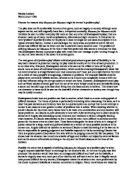It is with this ‘worldly realism’ that Lucio establishes his own character, and we can quickly observe his relevance in the grander scale of Measure for Measure. The play ultimately details the conflict between private behaviour and outward morality, a context that Lucio fits neatly into when compared to Angelo. One can immediately observe Shakespeare’s use of irony in language when we look at the names of the two characters. ‘Lucio’ recalls Lucifer, the archangel who rebelled against God, whilst ‘Angelo’ would appear more obviously saintly. This fits precisely with their apparent characterisation: Lucio would outwardly appear to be a sordid, even smutty character, relentlessly churning out bawdy pun after bawdy pun. Yet we know from when Mistress Overdone reveals to him what is to happen to Claudio that Lucio is quietly angered by the absurdity of Angelo’s sudden ressurection of the ‘neglected act’, condemning Claudio to death for what Lucio sees as a mere ‘game of tick-tack’. He is shrewd and clear-sighted, immediately offering his advice to the plight of Claudio. It is even Lucio who observes Angelo’s flaws, extending the implications of irony in the contrast between their two characters. Angelo would wish to appear to the citizens of Vienna to be the voice of morality, bravely crusading to clear the city’s streets of the evils of promiscuity and sex outside of wedlock. Yet, as Lucio himself observes, and as we learn later in the play, privately Angelo is a man whose self-centred ambition is open to corruption, and who is more disinterested in helping Vienna’s people than anyone.
As we meet Lucio for the second time, Shakespeare again creates incredibly strong dramatic impact, again with the swift contrast of setting, but this time using the tool of Lucio to full effect. Lucio fit so easily into the seedy settings of Bankside, yet as he travels to inform Isabella of her brother’s plight, he seamlessly moves into the surroundings of a nunnery. A lesser character would surely move awkwardly into such a scene, yet Lucio knows almost instantly how to act and how to speak. That he cannot resist trying a trademark joke ‘virgin – if that you be’ is forgivable- he does not repeat such a mistake after he realises it is totally unsuitable for the serious situation, and continues with the business of requesting Isabella’s assistance in gaining mercy for her brother.
Aswell as bringing into question the issue of private behaviour vs. outward morality, the character of Lucio is employed to delve into the simpler context of government, more specifically its Measure. Also central to the play is the debate on fair government and how it should be administered. Vienna is described as a society where ‘liberty plucks justice by the nose’, yet if the libertine Lucio were to have his way, ‘punishment’ would be received ‘in thanks’. This contasts starkly with the views of Angelo, whose ‘strict statutes’ and ‘biting laws’ are his choice of administration. When combined with the question of their characters, Lucio and Angelo’s views on law enforcement are fundamental to the play. It is unsurprising that it is Lucio’s views that ask the most questions of both Jacobean and contemporary society – for despite his bawdy punning he quickly establishes himself as more likeable and morally justified than Angelo, yet his liberal attitudes on the law seem to be the same as those of the Duke – the very same attitudes that have seen Vienna devolve into such a hotbed of promiscuity. Infact, The Duke and Lucio even share a view of Angelo. ‘He scarce confesses his blood flows’ says the Duke, whilst Lucio describes him as a man ‘whose blood is snow broth’. The fact that both of these men share views that have seen Vienna poorly served, yet the man whose views should be aimed for and aspired to does not really stand for his views, merely for himself. It is a complex web of morality that Shakespeare spins, using Lucio as the main player once again, as accessible and movable as ever.
On this subject it is interesting that Shakespeare’s first set of audiences in 1604 would certainly have included men from Whitehall who served under the reign of James I. James dealt with such issues of law enforcement in his book Basilicion Doron, and remarked that ‘laws are ordained as rules of virtuous and social living, and not as snares to trap your good subjects’. This is a view clearly held by both the Duke and Lucio, who, despite Lucio’s outward light-hearted promiscuity, are both morally proper men, whose apparently just resolution on law enforcement appears to have failed Vienna. I believe this also, albeit very subtly, brings into question the issue of the devine right of the monarch, an issue very topical at the time Measure for Measure was written. Just as the Duke, James I was a popular and good King, yet just as Vienna, London seemingly had a problem with prostitution, regardless of comparative extent. By showing, through the use of Lucio, that both the Duke and James I had the right idea on how to apply the law, yet their application was not appearing to be particularly effective, it would seem that Shakespeare brings the divine right issue into question, an issue that links neatly to that of morality of rule and of the ruling class’ obsession with monetary value – something explored at the very beginning of the play. Obviously as we come only to the close of Act 1 no resolutions are suggested for these issues, Shakespeare ever playing strongly on the ambiguity of the people and social problems residing within the Vienna of Measure for Measure.







